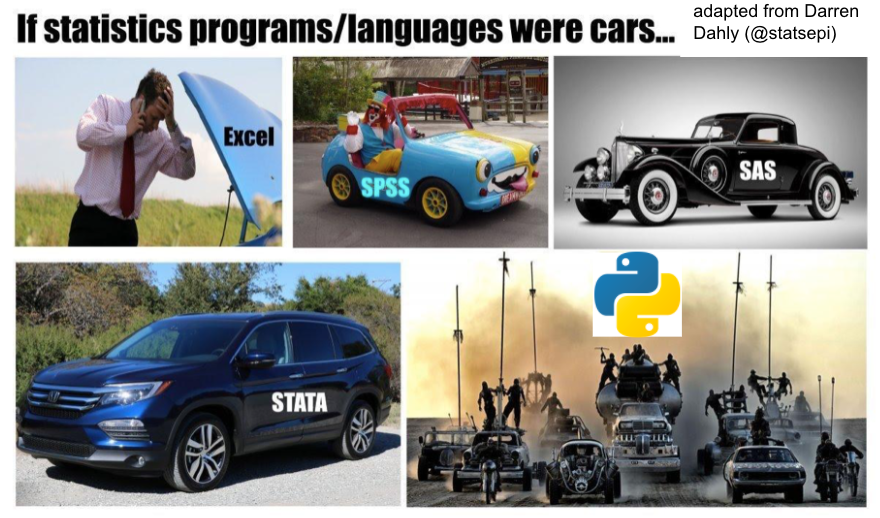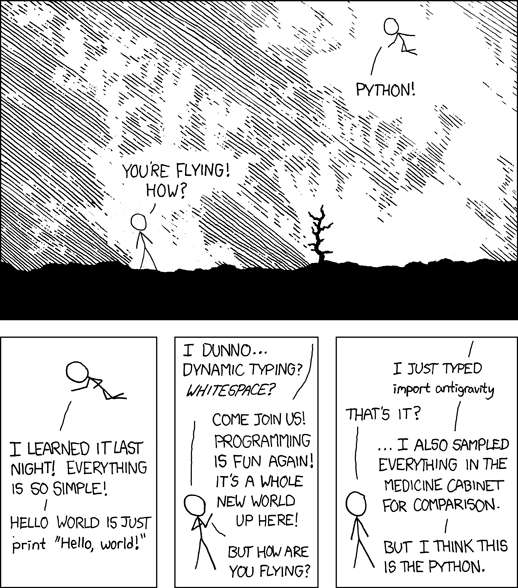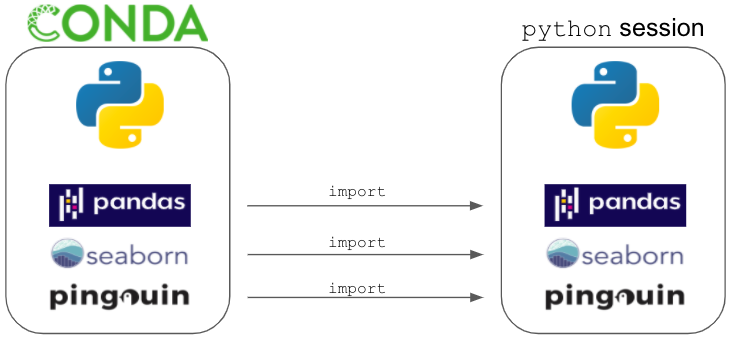Introduction V - Introduction to Python - I
Contents
Introduction V - Introduction to Python - I¶
Peer Herholz (he/him)
Habilitation candidate - Fiebach Lab, Neurocognitive Psychology at Goethe-University Frankfurt
Research affiliate - NeuroDataScience lab at MNI/McGill
Member - BIDS, ReproNim, Brainhack, Neuromod, OHBM SEA-SIG, UNIQUE
![]()
![]() @peerherholz
@peerherholz
Before we get started 1…¶
most of what you’ll see within this lecture was prepared by Ross Markello, Michael Notter and Peer Herholz and further adapted for this course by Peer Herholz
based on Tal Yarkoni’s “Introduction to Python” lecture at Neurohackademy 2019
based on http://www.stavros.io/tutorials/python/ & http://www.swaroopch.com/notes/python
based on https://github.com/oesteban/biss2016 & https://github.com/jvns/pandas-cookbook
Objectives 📍¶
learn basic and efficient usage of the python programming language
what is python & how to utilize it
building blocks of & operations in python
What is Python?¶
Python is a programming language
Specifically, it’s a widely used/very flexible, high-level, general-purpose, dynamic programming language
That’s a mouthful! Let’s explore each of these points in more detail…
Widely-used¶
Python is the fastest-growing major programming language
Top 3 overall (with JavaScript, Java)

High-level¶
Python features a high level of abstraction
Many operations that are explicit in lower-level languages (e.g., C/C++) are implicit in Python
E.g., memory allocation, garbage collection, etc.
Python lets you write code faster
File reading in Java¶
import java.io.BufferedReader;
import java.io.FileReader;
import java.io.IOException;
public class ReadFile {
public static void main(String[] args) throws IOException{
String fileContents = readEntireFile("./foo.txt");
}
private static String readEntireFile(String filename) throws IOException {
FileReader in = new FileReader(filename);
StringBuilder contents = new StringBuilder();
char[] buffer = new char[4096];
int read = 0;
do {
contents.append(buffer, 0, read);
read = in.read(buffer);
} while (read >= 0);
return contents.toString();
}
}
File-reading in Python¶
open(filename).read()
General-purpose¶
You can do almost everything in Python
Comprehensive standard library
Enormous ecosystem of third-party packages
Widely used in many areas of software development (web, dev-ops, data science, etc.)

Dynamic¶
Code is interpreted at run-time
No compilation process*; code is read line-by-line when executed
Eliminates delays between development and execution
The downside: poorer performance compared to compiled languages

(Try typing import antigravity into a new cell and running it!)
What we will do in this section of the course is a short introduction to Python to help beginners to get familiar with this programming language.
It is divided into the following chapters:
Here’s what we will focus on in the first block:
Modules¶
Most of the functionality in Python is provided by modules. To use a module in a Python program it first has to be imported. A module can be imported using the import statement.

For example, to import the module math, which contains many standard mathematical functions, we can do:
import math
This includes the whole module and makes it available for use later in the program. For example, we can do:
import math
x = math.cos(2 * math.pi)
print(x)
1.0
Importing the whole module us often times unnecessary and can lead to longer loading time or increase the memory consumption. An alternative to the previous method, we can also choose to import only a few selected functions from a module by explicitly listing which ones we want to import:
from math import cos, pi
x = cos(2 * pi)
print(x)
1.0
You can make use of tab again to get a list of functions/classes/etc. for a given module. Try it out via navigating the cursor behind the import statement and press tab:
from math import
Comparably you can also use the help function to find out more about a given module:
import math
help(math)
It is also possible to give an imported module or symbol your own access name with the as additional:
import numpy as np
from math import pi as number_pi
x = np.rad2deg(number_pi)
print(x)
180.0
You can basically provide any name (given it’s following python/coding conventions) but focusing on intelligibility won’t be the worst idea:
import matplotlib as pineapple
pineapple.
Exercise 1.1¶
Import the max from numpy and find out what it does.
# write your solution in this code cell
from numpy import max
help(max)
Exercise 1.2¶
Import the scipy package and assign the access name middle_earth and check its functions.
# write your solution in this code cell
import scipy as middle_earth
help(middle_earth)
Help on package scipy:
NAME
scipy
DESCRIPTION
SciPy: A scientific computing package for Python
================================================
Documentation is available in the docstrings and
online at https://docs.scipy.org.
Contents
--------
SciPy imports all the functions from the NumPy namespace, and in
addition provides:
Subpackages
-----------
Using any of these subpackages requires an explicit import. For example,
``import scipy.cluster``.
::
cluster --- Vector Quantization / Kmeans
fft --- Discrete Fourier transforms
fftpack --- Legacy discrete Fourier transforms
integrate --- Integration routines
interpolate --- Interpolation Tools
io --- Data input and output
linalg --- Linear algebra routines
linalg.blas --- Wrappers to BLAS library
linalg.lapack --- Wrappers to LAPACK library
misc --- Various utilities that don't have
another home.
ndimage --- N-D image package
odr --- Orthogonal Distance Regression
optimize --- Optimization Tools
signal --- Signal Processing Tools
signal.windows --- Window functions
sparse --- Sparse Matrices
sparse.linalg --- Sparse Linear Algebra
sparse.linalg.dsolve --- Linear Solvers
sparse.linalg.dsolve.umfpack --- :Interface to the UMFPACK library:
Conjugate Gradient Method (LOBPCG)
sparse.linalg.eigen --- Sparse Eigenvalue Solvers
sparse.linalg.eigen.lobpcg --- Locally Optimal Block Preconditioned
Conjugate Gradient Method (LOBPCG)
spatial --- Spatial data structures and algorithms
special --- Special functions
stats --- Statistical Functions
Utility tools
-------------
::
test --- Run scipy unittests
show_config --- Show scipy build configuration
show_numpy_config --- Show numpy build configuration
__version__ --- SciPy version string
__numpy_version__ --- Numpy version string
PACKAGE CONTENTS
__config__
_build_utils (package)
_distributor_init
_lib (package)
cluster (package)
conftest
constants (package)
fft (package)
fftpack (package)
integrate (package)
interpolate (package)
io (package)
linalg (package)
misc (package)
ndimage (package)
odr (package)
optimize (package)
setup
signal (package)
sparse (package)
spatial (package)
special (package)
stats (package)
version
DATA
test = <scipy._lib._testutils.PytestTester object>
VERSION
1.7.1
FILE
/Users/peerherholz/anaconda3/envs/pfp_2021/lib/python3.9/site-packages/scipy/__init__.py
Exercise 1.3¶
What happens when we try to import a module that is either misspelled or doesn’t exist in our environment or at all?
pythonprovides us a hint that themodulename might be misspelledwe’ll get an
errortelling us that themoduledoesn’t existpythonautomatically searches for themoduleand if it exists downloads/installs it
import welovethiscourse
---------------------------------------------------------------------------
ModuleNotFoundError Traceback (most recent call last)
/var/folders/61/0lj9r7px3k52gv9yfyx6ky300000gn/T/ipykernel_52496/1194139970.py in <module>
----> 1 import welovethiscourse
ModuleNotFoundError: No module named 'welovethiscourse'
Namespaces and imports¶
Python is very serious about maintaining orderly
namespacesIf you want to use some code outside the current scope, you need to explicitly “
import” itPython’s import system often annoys beginners, but it substantially increases
codeclarityAlmost completely eliminates naming conflicts and confusion
Help and Descriptions¶
Using the function help we can get a description of almost all functions.
help(math.log)
math.log(10)
math.log(10, 2)
Variables and data types¶
in programming
variablesare things that storevaluesin
Python, we declare avariableby assigning it avaluewith the=signname = valuecode
variables!= math variablesin mathematics
=refers to equality (statement of truth), e.g.y = 10x + 2in coding
=refers to assignments, e.g.x = x + 1
Variables are pointers, not data stores!

Pythonsupports a variety ofdata typesandstructures:booleansnumbers(ints,floats, etc.)stringslistsdictionariesmany others!
We don’t specify a variable’s type at assignment
Variables and types¶
Symbol names¶
Variable names in Python can contain alphanumerical characters a-z, A-Z, 0-9 and some special characters such as _. Normal variable names must start with a letter.
By convention, variable names start with a lower-case letter, and Class names start with a capital letter.
In addition, there are a number of Python keywords that cannot be used as variable names. These keywords are:
and, as, assert, break, class, continue, def, del, elif, else, except, exec, finally, for, from, global, if, import, in, is, lambda, not, or, pass, print, raise, return, try, while, with, yield
Assignment¶
(Not your homework assignment but the operator in python.)
The assignment operator in Python is =. Python is a dynamically typed language, so we do not need to specify the type of a variable when we create one.
Assigning a value to a new variable creates the variable:
# variable assignment
x = 1.0
Again, this does not mean that x equals 1 but that the variable x has the value 1. Thus, our variable x is stored in the respective namespace:
x
1.0
This means that we can directly utilize the value of our variable:
x + 3
4.0
Although not explicitly specified, a variable does have a type associated with it. The type is derived from the value it was assigned.
type(x)
float
If we assign a new value to a variable, its type can change.
x = 1
type(x)
int
This outline one further very important characteristic of python (and many other programming languages): variables can be directly overwritten by assigning them a new value. We don’t get an error like “This namespace is already taken.” Thus, always remember/keep track of what namespaces were already used to avoid unintentional deletions/errors (reproducibility/replicability much?).
ring_bearer = 'Bilbo'
ring_bearer
'Bilbo'
ring_bearer = 'Frodo'
ring_bearer
'Frodo'
If we try to use a variable that has not yet been defined we get an NameError (Note for later sessions, that we will use in the notebooks try/except blocks to handle the exception, so the notebook doesn’t stop. The code below will try to execute print function and if the NameError occurs the error message will be printed. Otherwise, an error will be raised. You will learn more about exception handling later.):
try:
print(Peer)
except(NameError) as err:
print("NameError", err)
else:
raise
NameError name 'Peer' is not defined
Variable names:
Can include
letters(A-Z),digits(0-9), andunderscores( _ )Cannot start with a
digitAre case sensitive (questions: where did “lower/upper case” originate?)
This means that, for example:
shire0is a valid variable name, whereas0shireis notshireandShireare different variables
Exercise 2.1¶
Create the following variables n_elves, n_dwarfs, n_humans with the respective values 3, 7.0 and nine.
# write your solution here
n_elves = 3
n_dwarfs = 7.0
n_humans = "nine"
Exercise 2.2¶
What’s the output of n_elves + n_dwarfs?
n_elves + n_dwarfs10
10.0
n_elves + n_dwarfs
Exercise 2.3¶
Consider the following lines of code.
ring_bearer = 'Gollum'
ring_bearer
ring_bearer = 'Bilbo'
ring_bearer
What is the final output?
'Bilbo''Gollum'neither, the variable got deleted
ring_bearer = 'Gollum'
ring_bearer
ring_bearer = 'Bilbo'
ring_bearer
Fundamental types & data structures¶
Most code requires more complex structures built out of basic data
typesdata typerefers to thevaluethat isassignedto avariablePythonprovides built-in support for many common structuresMany additional structures can be found in the collections module
Most of the time you’ll encounter the following data types
integers(e.g.1,42,180)floating-point numbers(e.g.1.0,42.42,180.90)strings(e.g."Rivendell","Weathertop")Boolean(True,False)
If you’re unsure about the data type of a given variable, you can always use the type() command.
Integers¶
Lets check out the different data types in more detail, starting with integers. Intergers are natural numbers that can be signed (e.g. 1, 42, 180, -1, -42, -180).
x = 1
type(x)
int
n_nazgul = 9
type(n_nazgul)
int
remaining_rings = -1
type(remaining_rings)
int
Floating-point numbers¶
So what’s the difference to floating-point numbers? Floating-point numbers are decimal-point number that can be signed (e.g. 1.0, 42.42, 180.90, -1.0, -42.42, -180.90).
x_float = 1.0
type(x_float)
float
n_nazgul_float = 9.0
type(n_nazgul_float)
float
remaining_rings_float = -1.0
type(remaining_rings_float)
float
Strings¶
Next up: strings. Strings are basically text elements, from letters to words to sentences all can be/are strings in python. In order to define a string, Python needs quotation marks, more precisely strings start and end with quotation marks, e.g. "Rivendell". You can choose between " and ' as both will work (NB: python will put ' around strings even if you specified "). However, it is recommended to decide on one and be consistent.
location = "Weathertop"
type(location)
str
abbreviation = 'LOTR'
type(abbreviation)
str
book_one = "The fellowship of the ring"
type(book_one)
str
Booleans¶
How about some Booleans? At this point it gets a bit more “abstract”. While there are many possible numbers and strings, a Boolean can only have one of two values: True or False. That is, a Boolean says something about whether something is the case or not. It’s easier to understand with some examples. First try the type() function with a Boolean as an argument.
b1 = True
type(b1)
bool
b2 = False
type(b2)
bool
lotr_is_awesome = True
type(lotr_is_awesome)
bool
Interestingly, True and False also have numeric values! True has a value of 1 and False has a value of 0.
True + True
2
False + False
0
Converting data types¶
As mentioned before the data type is not set when assigning a value to a variable but determined based on its properties. Additionally, the data type of a given value can also be changed via set of functions.
int()-> convert thevalueof avariableto anintegerfloat()-> convert thevalueof avariableto afloating-point numberstr()-> convert thevalueof avariableto astringbool()-> convert thevalueof avariableto aBoolean
int("4")
4
float(3)
3.0
str(2)
'2'
bool(1)
True
Exercise 3.1¶
Define the following variables with the respective values and data types: fellowship_n_humans with a value of two as a float, fellowship_n_hobbits with a value of four as a string and fellowship_n_elves with a value of one as an integer.
# write your solution here
fellowship_n_humans = 2.0
fellowship_n_hobbits = 'four'
fellowship_n_elves = 1
Exercise 3.2¶
What outcome would you expect based on the following lines of code?
True - Falsetype(True)
1bool
Exercise 3.3¶
Define two variables, fellowship_n_dwarfs with a value of one as a string and fellowship_n_wizards with a value of one as a float. Subsequently, change the data type of fellowship_n_dwarfs to integer and the data type of fellowship_n_wizard to string.
fellowship_n_dwarfs = 1.0
fellowship_n_wizards = '1.0'
int(fellowship_n_dwarfs)
1
str(fellowship_n_wizards)
'1.0'
Why do programming/science in Python?¶
Lets go through some advantages of the python programming language.

Easy to learn¶
Readable, explicit syntax
Most packages are very well documented
e.g.,
scikit-learn’s documentation is widely held up as a model
A huge number of tutorials, guides, and other educational materials
Comprehensive standard library¶
The Python standard library contains a huge number of high-quality modules
When in doubt, check the standard library first before you write your own tools!
For example:
os: operating system toolsre: regular expressionscollections: useful data structuresmultiprocessing: simple parallelization toolspickle: serializationjson: reading and writing JSON
Exceptional external libraries¶
Pythonhas very good (often best-in-class) externalpackagesfor almost everythingParticularly important for “data science”, which draws on a very broad toolkit
Package management is easy (
conda,pip)Examples:
Web development: flask, Django
Database ORMs: SQLAlchemy, Django ORM (w/ adapters for all major DBs)
Scraping/parsing text/markup: beautifulsoup, scrapy
Natural language processing (NLP): nltk, gensim, textblob
Numerical computation and data analysis: numpy, scipy, pandas, xarray, statsmodels, pingouin
Machine learning: scikit-learn, Tensorflow, keras
Image processing: pillow, scikit-image, OpenCV
audio processing: librosa, pyaudio
Plotting: matplotlib, seaborn, altair, ggplot, Bokeh
GUI development: pyQT, wxPython
Testing: py.test
Etc. etc. etc.
(Relatively) good performance¶
Pythonis a high-level dynamic language — this comes at a performance costFor many (not all!) use cases, performance is irrelevant most of the time
In general, the less
Pythoncode you write yourself, the better your performance will beMuch of the standard library consists of
Pythoninterfaces toCfunctionsNumpy,scikit-learn, etc. all rely heavily onC/C++orFortran
Python vs. other data science languages¶
Pythoncompetes for mind share with many other languagesMost notably,
RTo a lesser extent,
Matlab,Mathematica,SAS,Julia,Java,Scala, etc.
R¶
R is dominant in traditional statistics and some fields of science
Has attracted many SAS, SPSS, and Stata users
Exceptional statistics support; hundreds of best-in-class libraries
Designed to make data analysis and visualization as easy as possible
Slow
Language quirks drive many experienced software developers crazy
Less support for most things non-data-related
MATLAB¶
A proprietary numerical computing language widely used by engineers
Good performance and very active development, but expensive
Closed ecosystem, relatively few third-party libraries
There is an open-source port (Octave)
Not suitable for use as a general-purpose language
So, why Python?¶
Why choose Python over other languages?
Arguably none of these offers the same combination of readability, flexibility, libraries, and performance
Python is sometimes described as “the second best language for everything”
Doesn’t mean you should always use Python
Depends on your needs, community, etc.

You can have your cake and eat it!¶
Many languages—particularly R—now interface seamlessly with Python
You can work primarily in Python, fall back on R when you need it (or vice versa)
The best of all possible worlds?
The core Python “data science” stack¶
The Python ecosystem contains tens of thousands of packages
Several are very widely used in data science applications:
Jupyter: interactive notebooks
Numpy: numerical computing in Python
pandas: data structures for Python
Scipy: scientific Python tools
Matplotlib: plotting in Python
scikit-learn: machine learning in Python
We’ll cover the first three very briefly here
Other tutorials will go into greater detail on most of the others
The core “Python for psychology” stack¶
The
Python ecosystemcontains tens of thousands ofpackagesSeveral are very widely used in psychology research:
Jupyter: interactive notebooks
Numpy: numerical computing in
Pythonpandas: data structures for
PythonScipy: scientific
PythontoolsMatplotlib: plotting in
Pythonseaborn: plotting in
Pythonscikit-learn: machine learning in
Pythonstatsmodels: statistical analyses in
Pythonpingouin: statistical analyses in
Pythonpsychopy: running experiments in
Pythonnilearn: brain imaging analyses in `Python``
mne: electrophysiology analyses in
Python
Execept
scikit-learn,nilearnandmne, we’ll cover all very briefly in this coursethere are many free tutorials online that will go into greater detail and also cover the other
packages
Homework assignment #3¶
Your third homework assignment will entail working through a few tasks covering the contents discussed in this session within of a jupyter notebook. You can download it here. In order to open it, put the homework assignment notebook within the folder you stored the course materials, start a jupyter notebook as during the sessions, navigate to the homework assignment notebook, open it and have fun!
Deadline: 08/12/2021, 11:59 PM EST
